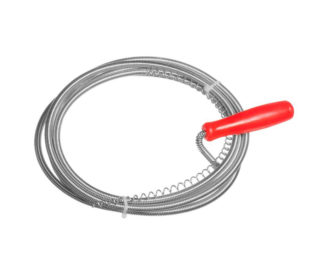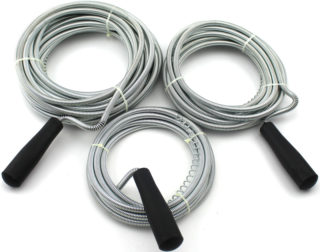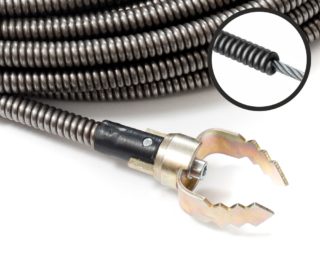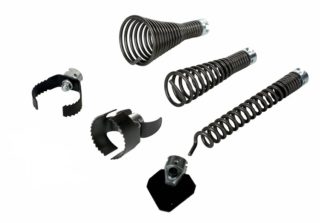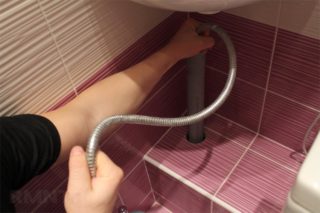Typically, pipe clogging problems most often occur in old pipelines. Modern metal-plastic sewer communications will almost never get clogged, provided that sanitation and safety rules are observed. However, you can clean the pipeline in a few minutes, it will take two people, but if you want, you can do it yourself. Consider the types of plumbing cables, instructions for use, useful tips.
Plumbing cable and its types
Spring loaded
The elastic, compressible cable can clean clogged pipe neatly without damage or jamming.
Pros:
- copes well with powder plugs, eliminates hair and coat;
- can be used by just one person;
- does not require great physical strength.
Minuses:
- relatively weak power;
- there is a moment of inertia;
- more space is required for easy cleaning.
In order to eliminate contamination as quickly and efficiently as possible, it is recommended to push the spring in a spiral and reciprocating motion so that the spring compresses and pulls the dirt along with it. The best option is to pull the spring by making a preliminary stop with your foot against the bathroom door jamb. If the cable springs back, then all the dirt will be outside, so you need to spread a newspaper.
REFERENCE! If you tighten the spring strongly, then after exiting the pipe, it will begin to spin and can damage objects nearby.
Spring-wound
Pros:
- solid power;
- elimination of any kind of pollution;
- high mobility.
Minuses:
- small contact area;
- an assistant is needed for cleaning.
As a rule, one of the partners is located near the very entrance to the pipe, making reciprocating movements, and the other stands behind and rotates the handle. So, the cable enters the pipe in a spiral and scrapes off all the dirt from the walls.
With a core
Pros:
- high rigidity;
- simplicity of the cleaning principle;
- high mobility.
Minuses:
- physical strength is required;
- will not help against hair, threads, similar stretching objects.
If two people can do the cleaning, then the process will go much faster, because the force directed in one direction is summed up.
Electric
An industrial version that is used by professionals for quick cleaning. Looks like a vacuum cleaner, only with a cable instead of a hose. The dimensions allow such a device to be carried without difficulty. The motor that starts the rotation runs almost silently.
Rope nozzles: types and applications
- hook. Helps to clean the pipe from hair and threads, pieces of fabric. Such a nozzle will be able to pull foreign objects out;
- peak.Helps with "cork" contamination, because such a nozzle will be able to break through the cork, and later the water will rinse the pipe. If handled improperly, such a nozzle can damage the pipe itself;
- combined nozzle. It is shaped like a mace tip and can handle any foreign object in the pipe. It is more difficult to damage its walls, but the effectiveness is much less.
Any nozzle can be used in any situation, it all depends on the geometry of the pipe and on the skill of the cleaner.
Step-by-step algorithm for clearing a blockage in pipes with a plumbing cable
- Clear the place of work from unnecessary objects. Any garbage or household items will hinder the action and slow down the process. In addition, if removed from the pipe, the cable can damage the plumbing.
- Place a cloth under the pipe so that the floor is not flooded when removing. There may be much more water in a glass than it seems.
- Carefully remove the pipe from the glass with rotary movements.
- Determine exactly where the stupor of water occurs, but it is better to spend time and clean it in both directions.
- Slowly insert the cable into the pipe and twist in the desired direction. The first 10-20 cm are very delicate, as the plastic pipe has thin walls and can be easily damaged.
- After the cable has entered the pipe and started moving, you need to go all the way to the stop.
- At the point of contact, you will need to complete steps 1-3.
- Then one of the partners must take the opposite end.
- Thus, the cable was threaded through the pipeline. With ordinary pulling movements, you can remove almost any dirt and forget about the problem.
- If it is not possible to open the second glass, it is recommended to take a spiral cable and repeat steps 1-6 several times, starting from the beginning. Each time, more and more debris should come out of the pipe.
- All these procedures can be done alone, but it is much more complicated.
Nuances and tips for use
Professional advice:
- Use different attachments in the same situation. Sometimes objects that are difficult to imagine even in the kitchen get into the pipeline. If after cleaning the water passes weakly, there is still a problem in the pipe.
- Do not push in excess of the norm if the nozzle suddenly rested and does not go well. Most likely, this is a pipe joint, and excessive pressure on it will only worsen the situation. To be sure of the correct motion vector, use the spiral input method, as they are the hardest to hit the joint.
- Do not use a rigid cable for one-way locations (those that cannot be accessed from the other end). If you puncture a pipe or provoke an accident, it will be very difficult to repair the leak, so it is better to use gentle methods or contact a professional.
- A homemade cable can be made from an ordinary television cable of the USSR model. Such wires are distinguished by a large amount of copper inside. They are quite tough but elastic, which is great for cleaning.
- Flush the pipe more often. After each run, it is recommended to run a medium amount of water through the pipe to remove fine dirt. Perhaps, after the "dam break", the dirt will be washed off with a stream of water and you will not have to clean it a second time.
- Only experienced ones can use a spring cable, because the moment of compression and inertia can play a cruel joke with the cleaner and leave him without teeth. Therefore, before starting the procedure, you need to take care of personal protective equipment.
What are the pipes clogged with?
An equally interesting rating that will shock readers:
- Washing powder.Almost all powders dissolve poorly in cold water, and even more so if it is winter outside, and the pipe passes through different temperature sectors. According to statistics, every winter 30% of apartments use services for cleaning pipes from washing powder. It clogs up in places where dirt accumulates, at bends, at joints with cast-iron pipes of the 90s model.
- Leftover food. Even if food leftovers go to the trash, and there is a filter on the drain, they still end up in the pipe. Moreover, food tends to absorb water and swell, which increases its danger to the pipeline.
- Hair. An urgent problem not only for the bathroom, but also for the kitchen. Of course, fewer of them get into the water supply, but in a few years you can get a solid hair ball out of there, which will be the size of an average washcloth.
- Mud. This refers to soil or clay. All the dirt that people wash off their shoes safely settles on the walls.
- Pieces of clothing. Buttons, threads, down, feathers from pillows, fur from collars. Not a lot, but in a few years such a combined ball will definitely accumulate.
- Cosmetics. Relevant for women. Most cosmetics are poorly soluble in water, so sooner or later it becomes clogged.
- Trans fats. Contained in store baked goods, convenience foods, fast food, margarine. If the disposal conditions are not followed, a huge viscous fat layer will form in the pipe, which will be difficult to remove even with a cable.

